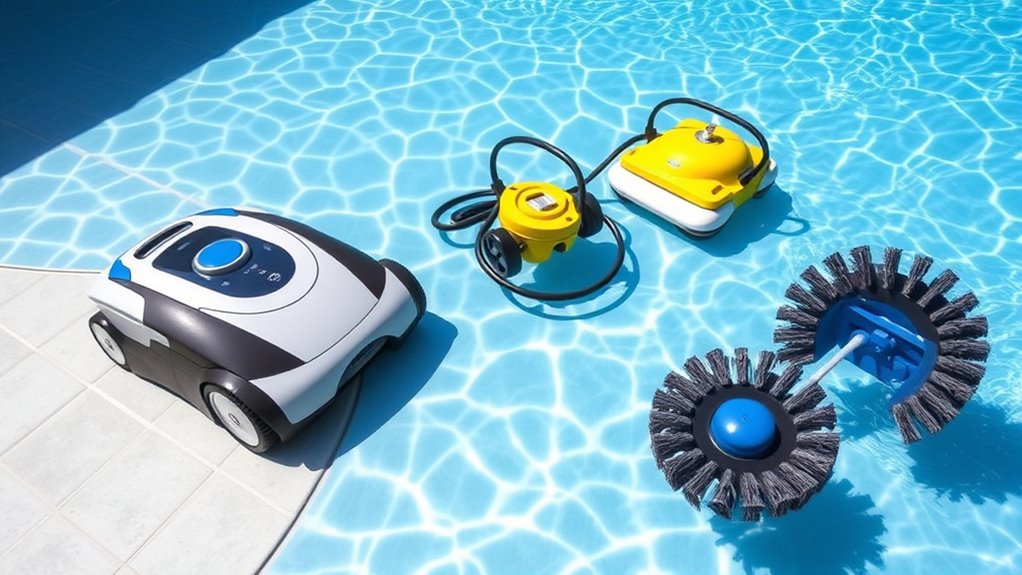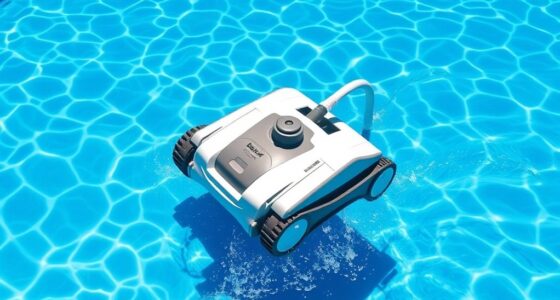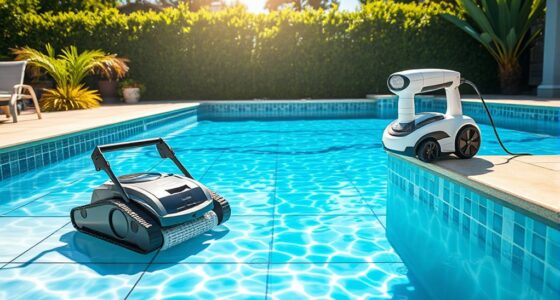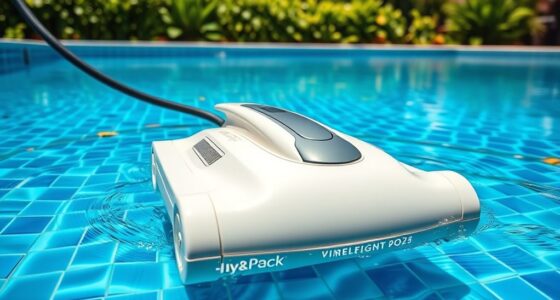Automatic pool cleaners make maintenance easier by automatically scrubbing surfaces and removing debris. There are three main types: robotic cleaners work independently, suction-side cleaners connect to your pool’s skimmer and rely on the pool pump, and pressure-side cleaners use water pressure to move debris into a bag. In-ground and above-ground pools may need different models, and choosing the right one depends on your pool size, features, and budget. Keep going to discover more about these options and how to choose the best for your pool.
Key Takeaways
- Understand the main types: robotic, suction-side, and pressure-side cleaners, and their operating mechanisms.
- Know installation differences, with in-ground cleaners requiring professional setup and above-ground options being simpler.
- Regular maintenance like cleaning filters and inspecting hoses ensures optimal performance and longevity.
- Consider pool size, shape, and features to choose a cleaner suitable for your specific pool.
- Proper chemical balance and scheduled cleaning improve efficiency and prevent debris buildup.
Robotic Pool Cleaners
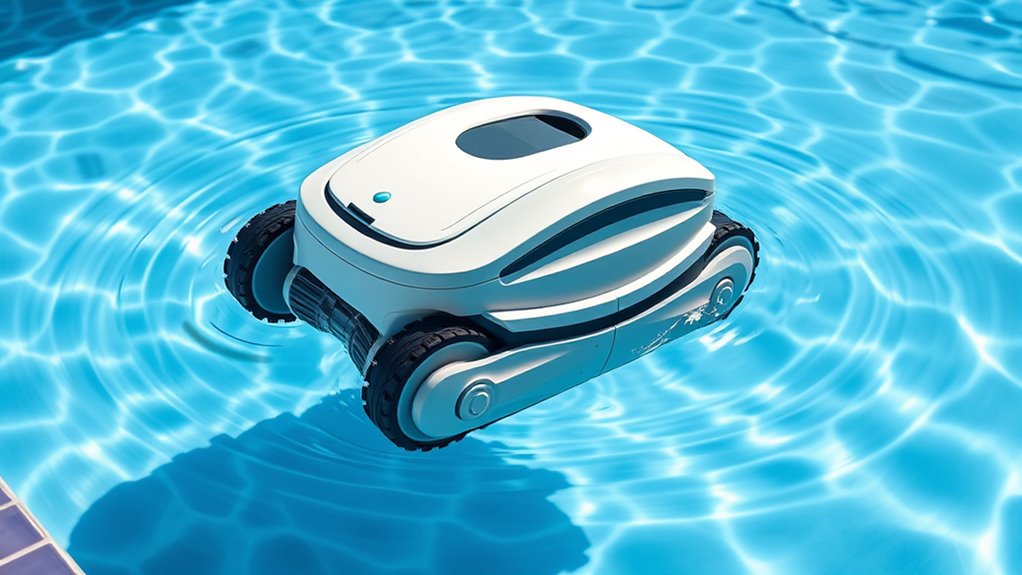
Have you ever wondered how robotic pool cleaners keep your pool spotless with minimal effort? These devices are a game-changer for maintaining swimming pool safety and ideal water quality. They automatically navigate your pool, scrubbing surfaces and removing debris, which helps keep the water chemistry balanced. By regularly cleaning, robotic cleaners prevent algae growth and reduce the need for harsh chemicals, promoting a healthier swimming environment. Their sensors detect dirt and obstacles, ensuring thorough coverage without damaging your pool’s surface. Plus, many models are energy-efficient and programmable, giving you convenience and peace of mind. When you choose a robotic cleaner, you’re investing in both safety and proper pool water chemistry, making your pool safer and easier to maintain. Additionally, understanding energy efficiency options can help you select the right device that minimizes operational costs while maximizing performance, just as choosing the right pool cleaner can optimize your water maintenance.
Suction-Side Pool Cleaners
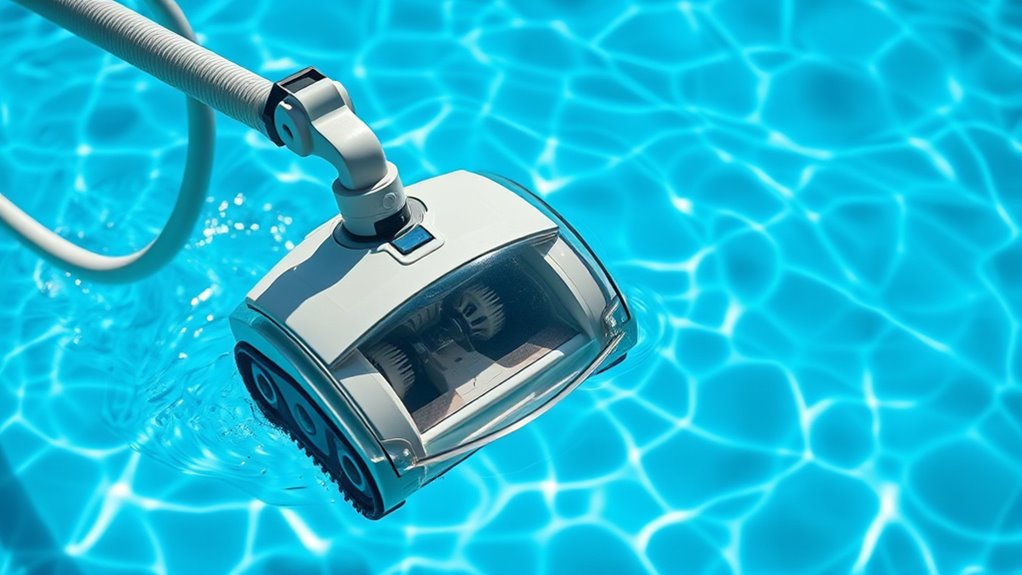
Suction-side pool cleaners are a popular choice for maintaining a clean and healthy pool with minimal effort. They connect directly to your pool’s skimmer or dedicated suction line, using the pool’s pump to operate. As they move around, they vacuum debris and dirt from the pool floor and walls. Water temperature can affect their performance; colder water may slow down their movement, while warmer water can enhance flexibility. To keep your pool chemical balance ideal, regularly check and adjust your pool’s chemical levels, ensuring the cleaner functions efficiently and prevents algae buildup. These cleaners are generally affordable and easy to install, making them ideal for routine maintenance. Just remember to clean the filter bag frequently for consistent suction and cleaning performance. Additionally, understanding the importance of contrast ratio can help you optimize your pool setting for better visibility and comfort during night swims. Regular maintenance and monitoring can also extend the lifespan of your pool equipment, ensuring optimal operation. Proper filter maintenance is essential for maintaining peak performance and avoiding clogs that could impair cleaning effectiveness. Furthermore, paying attention to tuning techniques can improve the overall efficiency and lifespan of your pool cleaning system.
Pressure-Side Pool Cleaners
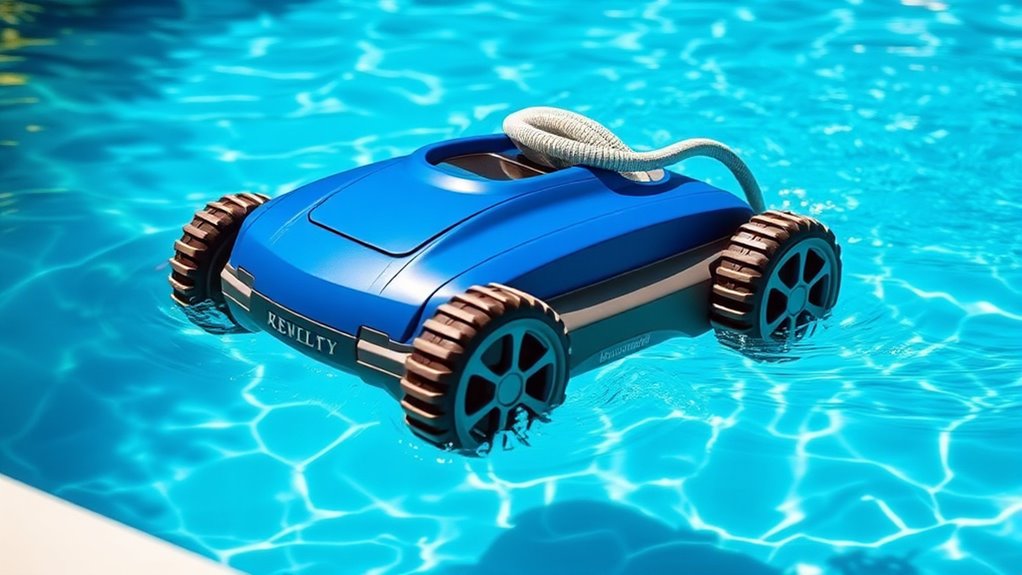
Pressure-side pool cleaners use your pool’s pump to move debris into a bag for easy removal, making them effective for larger debris. They offer advantages like energy efficiency and less wear on your pump, but they do require regular bag cleaning and occasional maintenance. Regular user consent management ensures that the operation of these devices complies with privacy policies, especially when integrated with smart pool systems. They also utilize essential oils for pool maintenance, which can help in reducing microbial growth and maintaining water clarity. Let’s explore how they work, their benefits and drawbacks, and what it takes to keep them running smoothly.
How They Operate
Ever wondered how pressure-side pool cleaners keep your pool spotless? They operate by attaching to a dedicated pressure line, which powers a turbine inside the cleaner. As water flows through, it creates suction, allowing the cleaner to move around and pick up debris. Unlike manual cleaning techniques, which require you to scrub and vacuum, pressure-side cleaners automate the process, reducing your effort. They also help maintain proper pool water chemistry by circulating water as they work, keeping chemicals evenly distributed. These cleaners typically have a bag or filter to collect debris, preventing clogs and ensuring continuous operation. By harnessing the pressure from your pool pump, they efficiently clean large surface areas without the need for manual intervention. Additionally, vetted products are available that meet safety and effectiveness standards for different pool sizes and types. Proper installation and regular maintenance can enhance their performance and longevity, making pool upkeep more manageable. Regularly inspecting and cleaning the debris bags can prevent blockages and optimize cleaning efficiency, which is a key part of pool maintenance. Moreover, understanding how pressure-driven systems operate can help you troubleshoot common issues and improve cleaning results. Recognizing the jet propulsion principle behind jet boats can also give you insights into how high-pressure water flow powers various machines and vehicles.
Pros and Cons
Pressure-side pool cleaners offer several advantages that make them popular among pool owners. They are efficient at cleaning larger debris, reducing the workload on your main pump and saving energy. Because they use the existing pool filtration system, they can be more energy-efficient than other cleaner types, helping you save on electricity bills. Additionally, their design minimizes disturbances to pool safety, ensuring safety during operation. To optimize their performance and longevity, regular maintenance practices such as cleaning filters and inspecting hoses are essential. However, they also have drawbacks. They rely on a dedicated booster pump, which can increase energy consumption if not managed properly. Some models may require more maintenance, especially with their hoses and filters. Also, they might not be as effective at cleaning fine debris or algae compared to robotic cleaners. Overall, pressure-side cleaners balance efficiency with convenience but require some initial investment and upkeep. Incorporating leadership skills such as strategic planning can help you manage maintenance and operational costs more effectively.
Maintenance Requirements
Maintaining a pressure-side pool cleaner requires regular attention to guarantee it operates efficiently. You should check and clean the debris bag weekly, especially during heavy use, to prevent clogs. Seasonal maintenance involves inspecting hoses and fittings for wear and ensuring proper chemical balancing to protect your equipment. Proper chemical levels prevent algae buildup and corrosion, extending your cleaner’s lifespan. Use the following table to understand key maintenance tasks:
| Task | Frequency |
|---|---|
| Clean debris bag | Weekly |
| Inspect hoses | Monthly or seasonally |
| Check chemical levels | Weekly |
In-Ground vs. Above-Ground Pool Cleaners
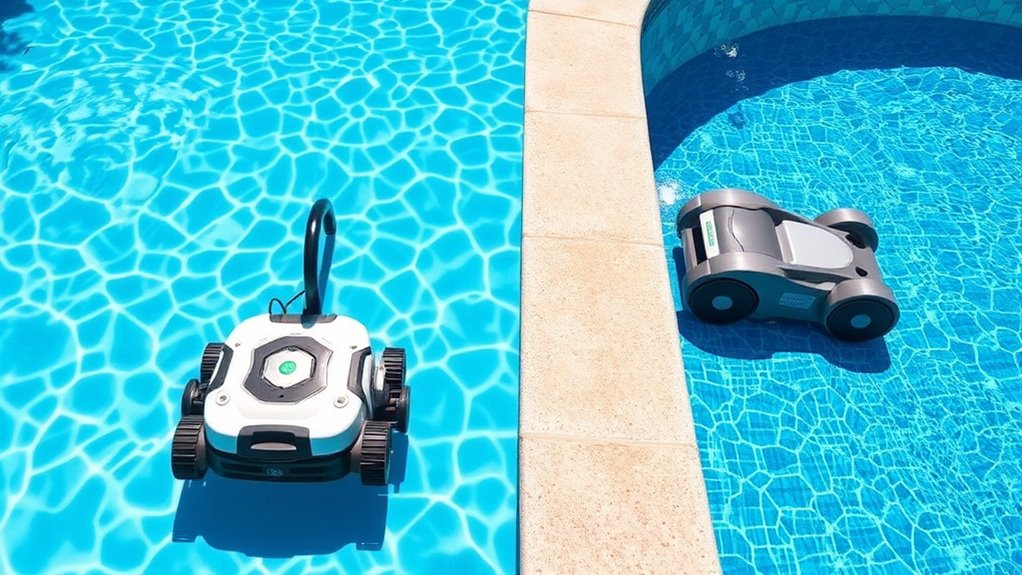
You’ll notice that in-ground pool cleaners typically require more complex installation and may need professional setup, while above-ground models are easier to install yourself. Cleaning performance can vary between the two, with in-ground cleaners often covering larger areas more thoroughly. Understanding these differences helps you choose the right cleaner for your pool type and maintenance needs. Additionally, Ford Tuning techniques and modifications can influence the performance of your vehicle, which may be a consideration if you’re also interested in customizing your equipment or accessories for pool maintenance.
Installation Differences
Installing automatic pool cleaners varies considerably between in-ground and above-ground pools, primarily due to their different structures and setups. In-ground pools often require more complex installation, which can present challenges like securing the cleaner’s power supply and ensuring proper suction lines. These tasks may demand professional installation to avoid issues such as leaks or improper movement. Above-ground pools are generally easier to set up because they are more accessible, with simpler plumbing and fewer structural constraints. Many above-ground models come with DIY installation kits, but you might still encounter installation challenges, especially with securing power sources or ensuring proper coverage. Hiring a professional can help you avoid common pitfalls and guarantee your cleaner functions efficiently from the start.
Cleaning Performance Variations
The cleaning performance of automatic pool cleaners can vary considerably between in-ground and above-ground pools due to differences in design and accessibility. In-ground pools often have more complex shapes and hard-to-reach areas, so your cleaner needs to be versatile and thorough, especially around pool safety features like steps and ladders. Above-ground pools typically have simpler shapes and easier access, which can make cleaning more efficient. However, maintaining proper chemical balance is vital in both types to prevent algae buildup and ensure your cleaner works effectively. A well-balanced chemical environment also promotes safe swimming conditions, reducing the risk of slips or accidents during cleaning. Understanding these differences helps you choose a cleaner that optimizes performance and maintains your pool’s safety standards.
Key Features to Consider When Choosing a Cleaner

When selecting an automatic pool cleaner, it’s essential to think about key features that match your pool’s size, shape, and cleaning needs. First, consider pool size—larger pools may need a more powerful or larger-capacity cleaner to guarantee thorough coverage. Second, check energy efficiency; a model that consumes less power saves money and reduces environmental impact. Third, evaluate the cleaner’s navigation system to verify it can efficiently maneuver your pool’s shape and obstacles. Additional features like filter capacity and ease of use can also influence your choice. Prioritizing these key features helps you select a cleaner that provides effective cleaning, saves energy, and suits your pool’s specific requirements.
How to Maintain Your Automatic Pool Cleaner
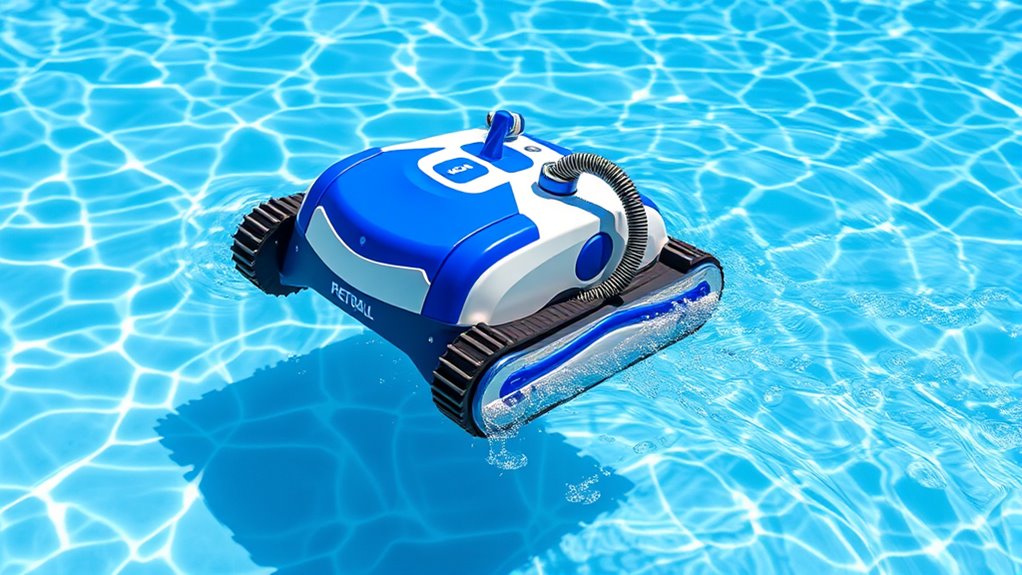
To keep your automatic pool cleaner performing at its best, regular maintenance is a must. Start by inspecting and cleaning the filter regularly to prevent clogs and ensure maximum suction. Check the hoses and brushes for debris or wear, replacing parts as needed. Maintaining proper pool chemistry is essential; balanced pH and chlorine levels prevent buildup that can hinder your cleaner’s effectiveness. Always follow safety precautions when handling chemicals or performing maintenance to avoid accidents. Rinse your cleaner after each use to remove dirt and prevent algae growth. Store it in a dry, sheltered area when not in use. Consistent upkeep not only prolongs your cleaner’s lifespan but also guarantees your pool stays clean and inviting.
Tips for Optimizing Pool Cleaning Efficiency
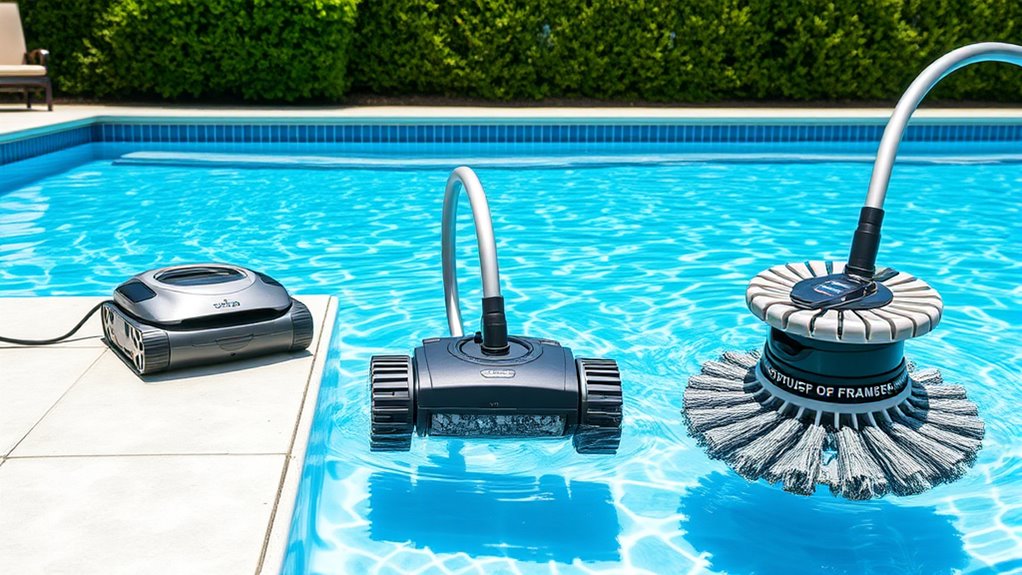
Maximizing your automatic pool cleaner’s efficiency requires strategic adjustments and proper operation techniques. First, ensure your pool’s water chemistry is balanced; improper pH or chlorine levels can hinder cleaning performance and damage the cleaner. Second, schedule regular cleanings during off-peak hours to reduce energy consumption and extend the cleaner’s lifespan. Third, keep the pool’s skimmer and filters clean to prevent debris buildup, which can slow down the cleaner and increase energy use. Additionally, monitor water levels—too low or high can affect movement and efficiency. Proper maintenance, combined with these adjustments, guarantees your cleaner works at its best, saves energy, and keeps your pool sparkling clean with minimal effort.
Frequently Asked Questions
How Long Do Automatic Pool Cleaners Typically Last?
You might wonder how long your automatic pool cleaner will last. Typically, they have a lifespan of around 3 to 5 years with proper use and regular pool maintenance. Factors like frequency of use, water quality, and maintenance routines influence lifespan expectations. To get the most out of your investment, clean filters regularly and follow the manufacturer’s guidelines. With good care, your cleaner can serve you well for several seasons.
Are Automatic Pool Cleaners Suitable for All Pool Shapes?
You might wonder if automatic pool cleaners suit all pool shapes. Generally, they work well with standard shapes, but pool shape compatibility varies. For custom pool designs, some cleaners may struggle with intricate layouts or unique features. To guarantee your cleaner fits, check the manufacturer’s specifications and consider models designed for complex or irregular pool shapes. Proper selection guarantees efficient cleaning regardless of your pool’s design.
Can I Use a Robotic Cleaner in Saltwater Pools?
Ever wonder if a robotic cleaner can handle saltwater pools? The answer is yes, but with caution. Robotic maintenance in saltwater pools is possible, yet you must choose a model designed to resist saltwater corrosion. Otherwise, you risk damaging your device over time. Select a robotic cleaner with corrosion-resistant components, and you’ll enjoy hassle-free cleaning without worrying about saltwater’s effects. The right choice keeps your pool pristine and your mind at ease.
Do Automatic Cleaners Work During Pool Seasons With Heavy Debris?
During seasons with heavy debris, automatic cleaners can still work effectively, but you might need to run them more frequently. Heavy debris can clog filters and reduce cleaner efficiency if not maintained properly. Regularly clearing out debris and checking the filter enhances cleaner effectiveness. While they handle seasonal debris well, staying on top of maintenance guarantees your automatic cleaner keeps your pool clean and ready for swimming, no matter the season.
Are There Eco-Friendly Options for Automatic Pool Cleaning?
Did you know that over 80% of pool owners want eco-friendly options? You can choose automatic pool cleaners powered by solar power, reducing electricity use and emissions. Some models use biodegradable materials, making them safer for the environment. These options help you keep your pool clean while minimizing your carbon footprint, so you enjoy a sparkling pool and contribute to a healthier planet at the same time.
Conclusion
Think of your pool cleaner as a trusted lighthouse guiding your waters through the stormy season. With the right choice and proper care, it’ll illuminate every corner, keeping your pool pristine and inviting. Like a steady beacon, your cleaner guarantees smooth sailing on your pool maintenance journey. Embrace it as a essential part of your backyard sanctuary, and watch your swimming haven shine brilliantly, ready for every splash and swim.
